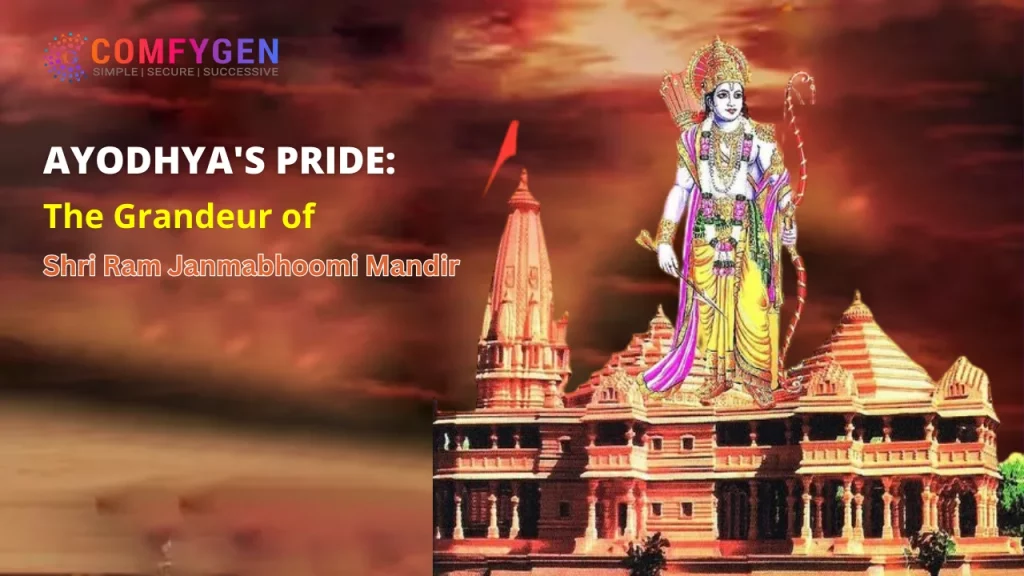Ayodhya’s Pride: The Grandeur of Shri Ram Janmabhoomi Mandir

We call it Ayodhya, but it is popular as Ram ji’s janambhumi.
Ayodhya, a renowned city traditionally linked to the contemporary Ayodhya, is celebrated as the birthplace of the Hindu deity Rama of Kosala and serves as the backdrop for the epic Ramayana and its various renditions. Due to its association with Rama’s birth, Ayodhya holds significant religious importance, being recognized as one of the seven principal pilgrimage destinations for Hindus.
Historical accounts suggest the existence of a temple at the presumed birth site of Rama, reportedly demolished under the directives of either Mughal Emperor Babur or Aurangzeb, with a mosque constructed in its stead. In 1992, a contentious dispute over the location resulted in the mosque’s demolition by Hindu groups, aspiring to reconstruct an imposing temple dedicated to Rama on the same site.
Table of Contents
- Know About Ayodhya District
- About Ram Mandir
- History and Foundation of Ram Mandir
- Architecture of Ram Mandir
- Darshan Timings of Ram Mandir
- Aarti Timings of Ram Mandir
- Conclusion
Know About Ayodhya District
Ayodhya, a city on the banks of the Sarayu river in Uttar Pradesh, India, is where the Ayodhya district and division offices are. The Ayodhya Municipal Corporation takes care of the city’s administration.
In the past, it was called Saketa. Ancient Buddhist and Jain texts talk about leaders like Gautama Buddha and Mahavira visiting and living here. Jain texts even say it’s the birthplace of five tirthankaras: Rishabhanatha, Ajitanatha, Abhinandananatha, Sumatinath, and Anantnath, linking it to the legendary Bharata Chakravarti. From the Gupta period onward, people started treating Ayodhya and Saketa as the same city.
Ayodhya, historically recognized as the early capital of the Kosala kingdom, underwent a transformation in significance over time. During the Buddhist era in the 6th–5th century BCE, Shravasti emerged as the primary city of the kingdom, though Ayodhya persisted as a notable center. Scholars widely assert that Ayodhya corresponds to the town of Saketa, where it is believed that Buddha resided for a period. The town’s Buddhist prominence is evident from Chinese monk Faxian’s 5th-century CE account, mentioning approximately 100 monasteries in Ayodhya. While the exact number may not be literal, Faxian emphasized the multitude of monastic establishments. Noteworthy monuments, including a stupa attributed to the Mauryan emperor Ashoka from the 3rd century BCE, also contributed to Ayodhya’s historical tapestry.
In the 11th and 12th centuries, Ayodhya, known as Oudh at that time, saw the rise of the Kanauj kingdom. It later became a part of different empires like the Delhi sultanate, Jaunpur kingdom, and by the 16th century, it became part of the Mughal Empire. In the early 18th century, Oudh gained some autonomy, but in 1764, it came under the control of the British East India Company. The British annexation in 1856 led to Oudh being integrated, and the loss of privileges for those who received hereditary land revenue became a trigger for the Indian Mutiny in 1857. In 1877, Oudh joined forces with the Agra Presidency to create the North-Western Provinces, eventually forming the United Provinces of Agra and Oudh, which is now the state of Uttar Pradesh.
Despite the town’s considerable age, there are limited remaining monuments of historical significance. The Babri Masjid, constructed in the early 16th century by Mughal emperor Babur, stands on a site traditionally associated with Rama’s birthplace and an ancient Hindu temple, the Ram Janmabhoomi. Due to its importance to both Hindus and Muslims, the site has been a frequent source of dispute. In 1990, unrest in northern India followed the mosque’s storming by Hindu nationalists aiming to build a temple there, leading to a crisis that toppled the Indian government.
Two years later, on December 6, 1992, the three-story mosque was rapidly demolished by a crowd of Hindu nationalists. The destruction triggered widespread riots in India, resulting in over 2,000 deaths. An investigative commission, led by retired judge Manmohan Singh Liberhan, was established in 1992 but did not release a report until 2009. The report caused controversy by attributing blame for the mosque’s destruction to several prominent figures from the pro-Hindu Bharatiya Janata Party. In 2010, a court ruling allocated the land between Hindus and Muslims, but in 2019, the Supreme Court overturned that decision, granting exclusive ownership of the property to Hindus.
About Ram Mandir
The Ram Mandir, currently in the process of construction in Ayodhya, Uttar Pradesh, India, stands at the historic site of Ram Janmabhoomi, believed to be the birthplace of Rama, a significant deity in Hinduism. The site holds historical significance as it was previously occupied by the Babri Masjid, constructed in the 16th century CE following the demolition of a pre-existing non-Islamic structure. In 1949, idols of Rama and Sita were placed within the mosque, which later faced an attack and eventual demolition in 1992.
In 2019, the Supreme Court of India ruled in favor of granting the disputed land to Hindus for the construction of a temple, allocating alternative land to Muslims for the construction of a mosque. The court’s decision was influenced by a report from the Archaeological Survey of India (ASI) indicating the presence of a structure beneath the Babri Masjid, characterized as non-Islamic. However, critics have vehemently disputed the ASI’s claims, citing them as contradictory, dubious, and potentially manipulated for nationalist purposes.
The groundbreaking ceremony, known as bhumi pujan, marking the initiation of the construction of the Ram Mandir, took place on 5 August 2020, conducted by Prime Minister Narendra Modi.The ongoing construction of the temple is under the guidance and supervision of the Shri Ram Janmabhoomi Teerth Kshetra Trust. The anticipated inauguration of the temple is set to take place on 22 January 2024.
The temple has become a subject of various controversies, with claims of misappropriation of donations, marginalization of key activists, and accusations of political manipulation by the BJP.
History and Foundation of Ram Mandir
Rama, a Hindu deity and an incarnation of Vishnu, is mentioned in the ancient Indian epic, Ramayana, as having been born in Ayodhya.
During the 16th century, Babur conducted a series of temple raids across northern India, resulting in the attack and destruction of the temple. Subsequently, the Mughals erected a mosque known as the Babri Masjid, believed to be situated on the Ram Janmabhoomi, the supposed birthplace of Rama. The earliest reference to the mosque dates back to 1767 in the Latin book Descriptio Indiae, authored by the Jesuit missionary Joseph Tiefenthaler. According to Tiefenthaler, the mosque was constructed by demolishing the Ramkot temple, considered to be Rama’s fortress in Ayodhya, along with the Bedi, identified as Rama’s birthplace.
The first recorded incident of religious violence occurred in 1853. In December 1858, the British administration prohibited Hindus from conducting puja (rituals) at the disputed site. Instead, a platform was established outside the mosque for the performance of rituals.
The sacred images, or murtis, of Rama and Sita were placed inside the Babri Masjid during the night of December 22–23, 1949, prompting the gathering of devotees from the following day. By 1950, the state assumed control of the mosque under section 145 of the Criminal Procedure Code (CrPC), permitting Hindus, but not Muslims, to conduct their worship at the location.
In the 1980s, the Vishwa Hindu Parishad (VHP), an organization affiliated with the Hindu nationalist collective Sangh Parivar, initiated a movement to reclaim the site for Hindus and construct a temple dedicated to the infant Rama (Ram Lalla) in that location. The VHP started gathering funds and bricks with “Jai Shri Ram” inscriptions. Subsequently, under the leadership of Prime Minister Rajiv Gandhi, the government granted permission for the Shilanyas (foundation stone ceremony), with the then Home Minister, Buta Singh, formally conveying approval to the VHP leader, Ashok Singhal.
Initially, both the Government of India and the Government of Uttar Pradesh had agreed that the Shilanyas would take place outside the disputed site. However, on November 9, 1989, a group of VHP leaders and Sadhus laid the foundation stone by excavating a 200-litre (7-cubic-foot) pit adjacent to the disputed land, where the main entrance (singhdwar) of the sanctum sanctorum was constructed. The VHP then laid the groundwork for a temple on the land next to the contested mosque. On December 6, 1992, a rally organized by the VHP and the Bharatiya Janata Party at the site, involving 150,000 volunteers known as karsevaks, turned violent. The crowd overwhelmed security forces and demolished the mosque.
Architecture of Ram Mandir
The initial blueprint for the Ram Mandir was conceptualized in 1988 by the Sompura family from Ahmedabad.[2] With a legacy spanning at least 15 generations, the Sompuras have been instrumental in designing over 100 temples globally, including the renowned Somnath temple. Heading the architectural endeavors for the temple was Chandrakant Sompura, supported by his two architect sons, Nikhil Sompura and Ashish Sompura.
In 2020, a revised design, incorporating some modifications from the original, was crafted by the Sompuras, adhering to Hindu texts, Vastu shastra, and Shilpa shastras. The dimensions of the temple are set to be 250 feet wide, 380 feet long, and 161 feet (49 m) high. Upon completion, the temple complex will rank as the world’s third-largest Hindu temple. The architectural style is rooted in the Gurjara-Chaulukya tradition of Nagara style, a prevalent form of Hindu temple architecture primarily found in northern India. A scale model of the proposed temple was unveiled during the Prayag Kumbh Mela in 2019.
The central edifice of the temple will be constructed upon an elevated platform spanning three stories. Within the garbhagriha (sanctum sanctorum) and along the entrance passage, there will be a total of five mandapas. On one side, three mandapas will be dedicated to Kudu, Nritya, and Rang, while on the opposite side, the remaining two mandapas will be designated for Kirtan and Prarthana. Adhering to the Nagara architectural style, the mandapas will be adorned with shikhara for embellishment.
The edifice will be supported by a total of 366 columns, each adorned with 16 idols representing various entities, including the incarnations of Shiva, the 10 Dashavataras, the 64 Chausath Yoginis, and the 12 manifestations of the goddess Saraswati. The staircase’s width is designated at 16 feet (4.9 m). Following the guidelines outlined in the scriptures for Vishnu-centric temple design, the sanctum sanctorum will assume an octagonal shape.
Spanning 10 acres (0.040 km2), the temple complex will encompass 57 acres (0.23 km2) of developed land, incorporating a prayer hall, lecture hall, educational facilities, as well as additional amenities like a museum and cafeteria. The temple committee envisions accommodating over 70,000 visitors at the site. Larsen & Toubro, offering their services pro bono, has undertaken the responsibility of overseeing the temple’s design and construction, serving as the project’s contractor. Collaborating institutions such as the Central Building Research Institute, National Geophysical Research Institute, and IITs in Bombay, Guwahati, and Madras are contributing expertise in areas such as soil testing, concrete, and design.
The construction endeavor will utilize 600,000 cubic feet (17,000 m3) of sandstone sourced from Baansi in Rajasthan. Remarkably, no iron will be incorporated in the temple’s construction, and the bonding of stone blocks will necessitate ten thousand copper plates. In a culturally significant gesture, Thailand is symbolically participating in the inauguration of the Ram Mandir by dispatching soil to the Ram Janmabhoomi. This gesture builds upon their prior act of sending water from two rivers in Thailand as a tribute to the temple.
Darshan Timings of Ram Mandir
Devotees can partake in the divine experience, known as temple darshan, from 7 am to 11:30 am. Furthermore, the temple reopens for darshan from 2 pm to 7 pm, providing extended opportunities for devotees to seek the divine presence
Aarti Timings of Ram Mandir
The Morning aarti or the Jagaran / Shringar Aarti is done at 6:30 a.m.
The Evening aarti or the Sandhya Aarti is done at 7:30 p.m.
For morning Aarti: Advanced Booking is available
For Evening Aarti: Same-day booking is available, subject to availability
Conclusion
A visit to the Ram Mandir is akin to a sacred pilgrimage into the heart of India’s cultural essence. It extends an invitation not only to the devout but also to the inquisitive, historians, and seekers. This inclusivity magnifies the temple’s role as a unifying force, potentially bringing together individuals from diverse backgrounds and beliefs under the expansive umbrella of shared cultural respect. This unity, nurtured in the presence of this awe-inspiring structure, has the potential to kindle a profound understanding and appreciation, erasing the boundaries of difference and fostering communal harmony.
Moreover, the temple stands poised to serve as a catalyst for the economic revival of Ayodhya. As pilgrims and tourists throng to the city, local businesses, artisans, and service sectors are primed to flourish. To facilitate and enrich this experience, one can seamlessly explore the city and its surroundings by utilizing the Savaari car rental app. This user-friendly service ensures that visitors can immerse themselves in the beauty and significance of Ayodhya without the inconvenience of transportation concerns.
The Ram Mandir, with its towering spires and sacred halls, extends a universal call to partake in its narrative, to witness the soul of India, and to contribute to its continuous journey towards harmony and progress.
Congratulations to the Ram Mandir Inauguration on January 22nd from the Comfygen team, may the grandeur of Shri Ram Janmabhoomi Mandir inspire unity and prosperity.










